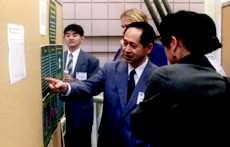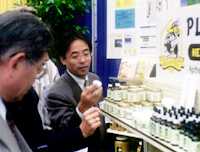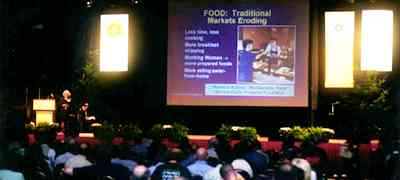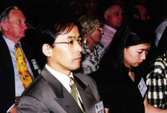|
The poster session
given by Professor Chiaki Kamei
from Okayama University generated substantial interest and reaction.

Okayama University
Professor Chiaki Kamei (center) and Dr. Yukio Sugimoto (left)
presented the results of their research on propolis at a poster
session.
|
|
Tuesday, September 14: Professor Chiaki Kamei and
his assistant, Dr. Yukio Sugimoto, from Okayama University. Their afternoon
poster session presented the results of their research on the effect
of propolis extract on D-galactosamine inductive liver disorder in rats.
Professor Kamei's team also conducts joint research with Yamada Bee
Farm.
Propolis is a resinous substance that bees use to caulk or cement the
entrance to and inner walls of their hive. It is also believed to prevent
bacteria entering the hive. Professor Kamei's research sought to determine
whether propolis had any effect on viral hepatitis. For this research,
rats were first injected with D-galactosamine to induce liver disorder.
The rats were then treated with propolis extract, which brought about
a noticeable improvement in the rats' condition. From these results,
it was hypothesized that flavonoids--the main ingredient in propolis--were
able to eliminate the active oxygen that causes liver disorder, thereby
protecting liver cells from destruction.
Similar test results were reported 15 years ago for experiments performed
in vitro. The current results were obtained using live animals, a feat
that attracted much attention from researchers from around the world.
During breaks I visited ApiExpo '99, which was held concurrently at
the large exhibition site. On display were educational displays by the
International Honeybee Association as well as publications, pharmaceuticals,
cosmetics, and other exhibits on honeybees and honey.

|
Studying bee products from around the world in the exhibition hall. |
|
One of my objectives for attending the congress
was to research unique ideas that can be developed by the company into
new products. Of particular interest were the many products made from
beeswax. I have long wanted to sell beeswax crayons in Japan that are
safe even if children put them in their mouths. At this point only two
companies in the world make and sell beeswax crayons--one in Germany
and one in Denmark. After exploring ApiExpo in depth, I concluded that
there are still many ways that bee products can be used to eliminate
toxicity from our lives.
The second half of the congress continued with more lectures and symposia.
At the closing ceremony held on the evening of Friday, September 17,
the baton was passed to the representative from South Africa, where
the next congress will be held in two years.
|








